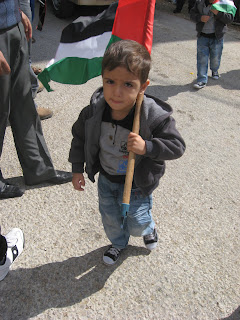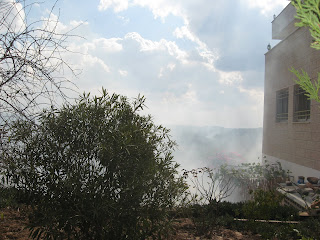
“If the Olive Trees knew the hands that planted them, Their Oil would become Tears.” ― Mahmoud Darwish
Saturday, November 5, 2011
Demo at Kafr Qaddum again [or time for the weekly dose of tear-gas]

It was Friday yesterday and this has come to mean “go to a demonstration” in our schedules these days. There are about five or six demonstrations happening on a regular basis on Friday throughout the West Bank nowadays but we felt like going back to the one in Kafr Qaddum again as it’s nearby, clearly Palestinian-led (when we were at Bil’in last week there were more internationals than Palestinians present, for example) and one we felt connected to in a way.
We met with activists from ISM and all of us filled a van that headed to the village. On the way we were stopped by a flying checkpoint. This is when soldiers show up unexpectedly at a random location to monitor traffic. Three soldiers stood at our door and started asking questions: where were we going, what for, etc. As previously agreed we replied that we were going to Qalqilia, the next village on our way, as tourists. The soldier who was doing the talking eyed us suspiciously; they very well knew we were headed to the demonstration. He asked again where everyone in the van was from and various countries names were voiced in reply, we weren’t any regular bunch of tourist and this was obvious. He decided to let us though and with a very ironic voice concluded our “meeting” accentuating every word pronounced: “Welcome to [pause] Israel”. Then we continued our separate realities having tramped lies like this: ours was about our destination, his was about our location; he very well realized we were in Palestine, himself included. He would not be dressed in this uniform of his and carrying his silly weapons otherwise, would he.
As we arrived in Kafr Qaddum it became clear from the very beginning that this demo was going to be different, bigger and more organized. More than a hundred people had gathered, few other internationals apart from us as well. The local council of the village had prepared a number of big posters with the image of Abu Mazin (Palestinian president Mahmoud Abbas) in support of his going to the UN. A smaller poster read “UNESCO said Yes to Palestine” and a third one had the image of the Foreign Israeli Minister Avigdor Lieberman and condemned his opposing the UNESCO vote. Children took a poster in hand and the weekly protest this Friday started with them in the front lead. They seemed so happy and proud, lined up by the organizer as if they were at school holding the letters of the alphabet and getting ready for the annual picture to give to their parents. Well, this is their alphabet nowadays, I thought.
There were five minutes of a pause there during which soldiers were advising one another and two sides faced each other peacefully. Then the army announced on their loudspeaker what I understood to say: “We will follow military procedures now, we have warned you”. At that we retreated back to where the Palestinians made a road block and the action started: a couple of stones thrown from the Palestinian side, tear gas shot immediately back from the Israeli one, many canisters at a time and right at the demonstrators. The army was not joking indeed. While shooting tear gas the soldiers would advance little by little towards us till after one hour they were already inside the village.There were a lot of canisters yet again coming straight at us and fast during this whole time. I choose to stay in the fronts this time and there was a lot of running, canisters falling all around us. Two Palestinians got injured: one of them was hit with a tear-gas canister in the hand and was taken away by the ambulance; another one broke his foot while running away from the tear-gas canisters.
Despite all of this the mood among the demonstrators was merry, whether because of the adrenaline in the whole situation or simply because this time there was a clear and strong resistance on the part of the Palestinians. They made a few roadblocks out of stones so that the army would not be able to come inside the village with their jeeps. After, they set three tires on fire hoping that the smoke would bother for a while the soldiers. It was their only opportunity to confront the oppressor, to resist and I could see this as an important outlet of emotions for the demonstrators. The stones thrown by the Palestinians are usually thrown by the youngsters, the teenagers who must have accumulated a lot of frustration and it was now their time to enact some of that. The soldiers looked like aliens, they were armed with everything possible: gas masks, of course, shields and what not. Throwing stones on them wasn’t going to hurt them, it was symbolic. People have the right to resist. And that’s how I can explain why the Palestinian adults put up with the stone throwing by the young people in the village at demonstrations: it’s their weekly therapy in a way and I must admit that I understand it after having spent just a month here.
I could take almost no pictures at all during the tear gas shooting; there was not much time to do so. The second picture on the right shows this house's yard filled with tear-gas. Tthis time the canisters were not only aimed at the demonstrators directly but they were shot at houses as well. Two donkeys weren’t spared just the same. A canister almost hit one of them but the poor animal was fast enough to jump aside and avoid it. We learnt after the demonstration’s end that two people have needed treatment for gas inhalation. Towards the demo’s end we saw an entire family go out from one of the houses, all children crying. They had tear gas in their house [I suppose yard] and had to come out.
There was a sense of tangible spiritual victory for the Palestinians on this demonstration in the air despite all the brutal forces used by the Israelis on us. Or maybe exactly because they had fallen as low as to use such. After the end of the protest Palestinian men walked around the village together singing with big smiles on their faces. They had resisted!
Subscribe to:
Post Comments (Atom)







No comments:
Post a Comment